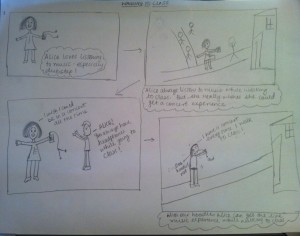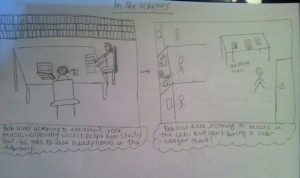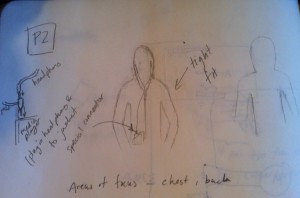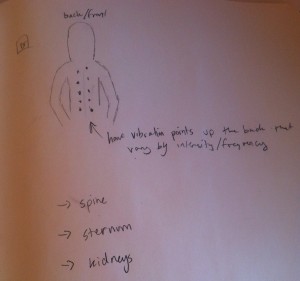Group Name: VARPEX
Group Members and Contributions: Abbi Ward, Dillon Reisman, Prerna Ramachandra, Sam Payne
Dillon recorded participant answers and wrote up information about our participants/people we observed and their responses and gathered test subjects.
Sam provided the music and music equipment, recorded the answers to the task analysis questions and gathered test subjects.
Abbi drew some of the sketches and wrote up information about the contextual interviews.
Prerna drew the storyboards, gathered some of the test subjects and helped with conducting interviews and compiled the blog post.
Group Number: 9
Problem and Solution Overview
We are addressing the problem that the concert experience can only be replicated by expensive, non-portable hardware. Further, these systems cause noise pollution in tight-living quarters. We will create an article of clothing worn on the torso that will use vibrating motors to generate stimulus similar to that created by loud bass – that is, a vibrating sensation on the skin. Our solution is portable, relatively inexpensive, and avoids the noise pollution problem.
Description of Users Observed in Contextual Enquiry
The target group of users we observed were students aged 18-22. They all have enjoyed listening to music at eating clubs on weekends or going to the occasional concert. They do these things, however, for a variety of different reasons. Some go to clubs for the social aspect of it (their friends are there, their friends are performing, etc.). Most, however, find the act of listening to the music enjoyable in its own right. The observed users enjoy many forms of music, and for most that includes some form of electronic music, though they had varying opinions on the quality of dubstep specifically. It helps that what is played in clubs is mostly of this type, as opposed to rock or other genres.
Contextual Inquiry Interview Descriptions
We invited six individuals to Sam Payne’s room on a Saturday afternoon. Sam has a good quality subwoofer which we used to experiment with different bass frequencies. We invited individual participants to the room at different times. We introduced ourselves and described the class and the purpose of the questions we were going to ask. For each participant, we walked through a series of questions about their music-listening habits and tried to get a feel for how, when, and why these students are listening to music. We then played a series of frequencies for them (from 110 Hz down to 50Hz) while they stood next to the subwoofer. We asked them to describe the sensation and where they felt it. We then put a foam chair near the subwoofer and had them listen to the tones again. We asked them to describe the sensations again, where they felt it, and how they liked it.
As participants answered our questions, we recorded their answers in this form, which gives a basic outline of the sorts of questions we asked.
Most of our users primarily listen to music in their dorms with laptop speakers. If they go outside, they’ll typically use headphones. These headphones are generally low-quality earbuds rather than slightly higher quality over-the-ear headphones. Many students will listen to music on speakers in whatever lab they’re working in. The participants we interviewed enjoyed a variety of genres, from dubstep and electronica to pop and opera. Even if the participants did not report that electronica or dubstep was very high on their list of favorable genres, they often at the very least appreciated it for its diverse and interesting sound and the “intense” sensation they often got from it.
Users felt the vibrations in very different locations. Some of this difference may have been due to different body types. The tall, thin men we interviewed felt vibrations very strongly in the top of their chest but other participants did not feel these vibrations as strongly. Another area where sensations were strongly felt was in the mid-back, along the spine. Users enjoyed the chair, as opposed to just feeling the vibrations in the air. The chair produces a more intense diffusion of vibration. People likened this feeling to a massage of the back and legs. This suggests that users enjoy the intensity of response and the similarity to the raw air experience may not be as important.
Answers to Task Analysis Questions
1. Who is going to use system?
This system would be for people ages 16-34 who enjoy concerts. They enjoy concerts because of the sensation derived from loud music, and would like to have this same sensation when they listen to music at home.
2. What tasks do they now perform?
They go to concerts when they can, and they play loud music in their home (if they can). Some individuals, such as college students living in dormitories, must listen to music through headphones due to noise pollution.
3. What tasks are desired?
Users would like the concert experience on-the-go and without disturbing their neighbors.
4. How are the tasks learned?
Users already know how to use their headphones and feel music. Our system would be an extension of simply plugging in your headphones.
5. Where are the tasks performed?
People feel music at concerts, parties and in dorms/apartments, if they have good speakers. People listen to music everywhere.
6. What’s the relationship between user & data?
Feeling music is a subjective experience, so our data is the reported experience of users. There may be some loss of data if users cannot describe or are not aware of factors that affect their experience.
7. What other tools does the user have?
Depending on the situation, the user may have headphones or speakers and subwoofers. They also have music-playing devices, such as iPods, computers. This equipment varies in expense.
8. How do users communicate with each other?
At concerts, people communicate through gesture and yelling.
9. How often are the tasks performed?
How often tasks are performed varies between individuals because it depends on the type of equipment they have. Those without subwoofers only feel music at concerts so they may feel music a few times per year. Those with subwoofers may feel music on a daily basis.
10. What are the time constraints on the tasks?
At a concert, the time of the concert constrains when users can listen and feel music. For those with good speakers and subwoofers, the constraint may be the time it takes for your neighbors to call public safety.
11. What happens when things go wrong?
If the concert is cancelled, the police are called, or your speaker breaks, you don’t listen and feel your music.
Descriptions of the Three Tasks
1. Many times, people want to listen to music at a loud volume in their room while roommate is studying, or without disturbing their neighbors. Many students will listen to music on headphones. However, the physical sensation of listening to music is lost while listening on headphones. This product would allow people to feel that sensation without disturbing those around them. The task of listening to music loudly in your room is easier than the other tasks, but it becomes more difficult as you take into consideration the possibility of disturbing your neighbors.
- Users working outside of their rooms often listen to music while working. The portability of this device allows users to feel music while studying without disturbing those around them.
2. Many students listen to music while walking to class. This of course is done on headphones since speakers are not portable. However, again, the physical sensations of listening to music are lost while listening on headphones. The portability of this product would allow students to listen and feel their music in any setting, and on the go. The task of listening to loud music while moving is difficult, and is even more difficult when you take into consideration the possibility of disturbing other persons.
3. While at concerts, many people enjoy the feeling of music, and some songs are even written to promote these sensations. While producing music, artists could use this product to feel their music and gauge how their music will feel in a concert setting. Attending concerts is difficult due to availability and cost.
Storyboards
Storyboard 1
Storyboard 2
Storyboard 3
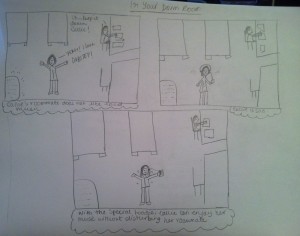
Listening to music in your room, and getting the live music experience without disturbing your roommate
Design Sketches
Interface Design Description
Since our system will be wearable, it will grant the user a lot of freedom over where and when they can ‘feel’ their music. Ideally it will also look inconspicuous in its function; a user should be comfortable simply wearing it as a jacket or other article of clothing. It will still enable the user to simply listen to music should they wish, as they did before, but with the added ability to activate the more immersive ‘feeling’ system through vibrating motors. Currently this ability is not offered by any product on the market- headphones do not offer users the concert-going experience of ‘feeling music’.

